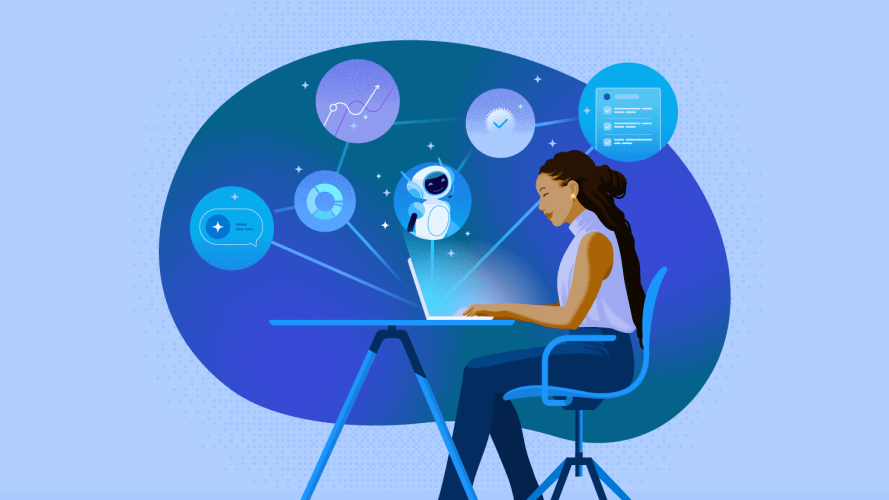Why CRM Is the Trusted Foundation of the Agentic Enterprise

CRM isn’t just data storage. It’s the memory, logic, and governance that give AI agents the context and rules to get real work done.
Key Takeaways
Large language models are impressive. They generate text that sounds smart, sometimes even magical. They improvise, handle unpredictable input, and can simulate creativity like a pro. But when it comes to enterprise work? They’re unreliable co-workers, at best.
Here’s the hard truth: Large language models (LLMs) can’t be trusted to do enterprise work. Not on their own.
That’s where customer relationship management (CRM) comes in.
CRM isn’t just a contact list. It’s where you run your business. It defines your rules, structures your processes, and grounds your data. Without it, your shiny new AI is just guessing — or worse, hallucinating.
AI needs rules — CRM supplies them
An LLM is a sophisticated AI system trained on vast amounts of data. GPT-5 from OpenAI and Grok 4 from xAI are popular examples. Ask an LLM, “Which of our top 50 customers haven’t received a renewal email and also have an open support case from the last 30 days?” and it’ll give you a confident answer. But will it check all the right systems? Apply the correct filters? Follow data privacy rules?
LLMs show what researchers call jagged intelligence: They can sound brilliant one moment and stumble on basics the next. ChatGPT couldn’t correctly answer how many times Tiger Woods won the PGA Tour. Studies have found that LLMs sometimes can’t work through simple logic puzzles or basic math questions.
Now, imagine the stakes are higher: for example, a healthcare agent asks about a billing issue, and the AI accidentally pulls medical history into the response. That’s how sensitive data is unintentionally exposed.
LLMs are great at generating language. But their reasoning, though improving, is still inconsistent and is not grounded in your business context: your data, rules, or goals. If you want AI to take reliable action, it needs structure. Memory. Governance. Access controls. Workflows. You know, the things CRM does best.
LLMs make your systems more creative. CRM is the business engine that makes them trusted.
What is CRM?
Our free guide gives you all the CRM basics, including what it does, its benefits, and why a CRM system is important for your business.



Why AI alone falls short
Let’s be clear: LLMs are not business engines. They’re pattern-matching machines that sound smart but don’t inherently know anything. They can’t:
- Remember what happened five minutes ago without help
- Apply business rules consistently
- Spot when they’ve broken policy
- Connect to your workflows, roles, or real-time data
- Enforce row-level sharing or access control
- Know when to bring in a human for judgment calls
And that’s before you throw in compliance, access control, or customer nuance.
Some claim reasoning engines can replace CRM. But LLMs don’t manage workflows, enforce policies, or understand enterprise context. They generate text; CRM runs the business. And unlike CRM, LLMs are a black box: You can’t audit them, govern them, or apply fine-grained controls. Confusing the two isn’t bold innovation. It’s a fast track to broken processes and bad decisions.
The future is agentic, but it still needs a system
“Agentic AI” sounds cool — and it is. It’s what happens when LLMs get tools, memory, and orchestration. Suddenly, they can book meetings, generate summaries, and write emails.
That’s an impressive leap beyond basic chat, but they still aren’t ready to handle enterprise-grade actions. Today’s agents can:
- Write a flawless renewal email, but might use outdated pricing or send it to the wrong person.
- Summarize a customer call, but won’t update records, escalate to sales, or flag compliance risks.
Without business context, rules, and governance, they stay stuck at “helpful assistant” instead of becoming a trusted co-worker.
What’s your agentic AI strategy?
Our playbook is your free guide to becoming an agentic enterprise. Learn about use cases, deployment, and AI skills, and download interactive worksheets for your team.

Why CRM is the best foundation for AI agents
CRM isn’t just data storage. It’s the memory, logic, and governance that give AI agents the context and rules to get real work done. CRM gives AI agents:
- Metadata to define business structure and terminology
- Identity: ensure every action is securely tied to the right customer, employee, or partner
- Memory: persistent customer history, context, and status
- Governance: access controls, permissions, and data protection
- Logic-based deterministic workflows to ensure tasks follow the right rules every time
- Agent lifecycle management: testing, observability, and continuous optimization
- Channels like email, mobile, web, and Slack for seamless agent engagement
- Human handoff with full context: no repetition, no confusion
In other words, CRM gives AI the tools to do real work, safely and at scale.
Now, with AI and CRM, a bank can process a debit order reversal (where a customer disputes a debit card charge) in less than five minutes. A healthcare practice can generate immediate care summaries of patient visits with medical histories, prescription records, and claims.
CRM is the trusted foundation, and in an agentic enterprise it becomes even more powerful when it’s paired with data, identity, and analytics that help AI act with confidence and precision.
This is where Salesforce uniquely extends CRM into a full agentic platform: Data Cloud unifies and activates information across systems. Tableau helps humans and agents see and understand data, bringing context to every decision. And with Slack, Salesforce delivers the first human-agentic conversational interface, where humans and agents collaborate side by side.
Humans and AI agents drive customer success together
AI agents qualify leads, resolve issues, and surface insights instantly, and across every channel. But it’s humans who build trust, make judgment calls, and create lasting relationships.
The real power isn’t just what agents do. It’s how they hand off — with full context, no repetition, and no confusion. That’s how work flows between AI and humans. Cleanly. Reliably. Together.
That only works when your platform knows your business: the data, the processes, the policies, and the people.
CRM isn’t just part of that platform; it’s where people work. It’s the shared space where teams act on insights, manage relationships, and keep customer experiences moving forward.
This is why CRM is the trusted foundation that powers humans and AI agents to work with accuracy, consistency, and scale in the agentic enterprise. And Salesforce is the best way to get there — with trusted CRM at the core, Data Cloud to activate your data, Tableau to turn it into decisions, Slack as the world’s first human-agentic conversational interface, and Agentforce to deploy AI agents that move AI beyond talk, into trusted action at scale.





























